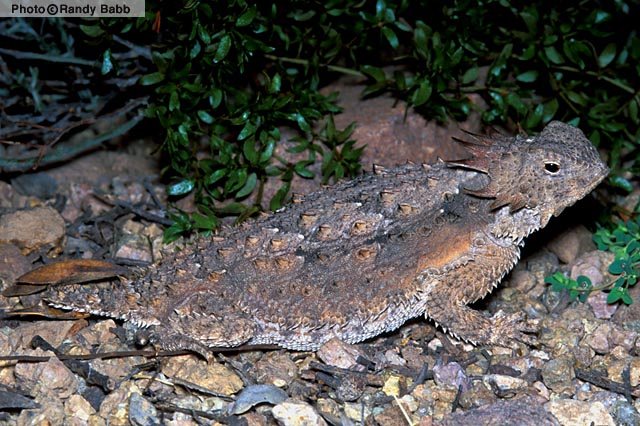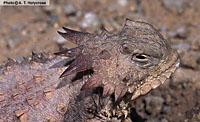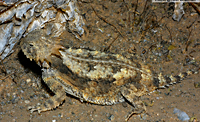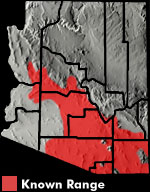Online Field Guide to The Reptiles and Amphibians of Arizona



Cochise County, AZ
 Cochise Co., AZ |
| REGAL HORNED LIZARD Phrynosoma (Anota) solare | |
|
DESCRIPTION: A medium-sized (up to 117 mm or 4.6″ from snout to vent), exceptionally flat and wide lizard with a short tail and a crown of flattened, dagger-like horns radiating from the back of the head. The base of each of the four central horns is in contact with that of its neighbor distinguishing this lizard from all other horned lizards in Arizona. Several isolated, pointed scales project from the back. Each lower side of the body is edged with a single fringe of enlarged, pointed scales. The anterior surfaces of the limbs are covered with enlarged, keeled, pointed, projecting scales. Base coloration is usually reddish brown, tan, or gray and usually matches the soil on which the animal lives. The center of the back is usually noticeably lighter in color than the sides of the body. There are often two dark, muted, and soft-edged blotches on the neck. The underside is pale with small, dark spots. Some specimens have a faint, light colored stripe running down the middle of the back. DISTRIBUTION: This lizard is distributed across southeastern Arizona and along the southern transition zone of our central mountains region. In our state it occurs at elevations ranging from about 900′ to about 4,500’. HABITAT: The range of this lizard in Arizona is within Arizona Upland Sonoran Desertscrub, Chihuahuan Desertscrub, and Semidesert Grassland communities. It inhabits valleys, rocky bajadas, and low foothills. It is usually encountered in relatively level areas with low shrubs, and open, sunny patches. BEHAVIOR: This diurnal ground-dweller can be active at any time of the year but winter activity is usually restricted to unseasonably warm days. It seeks shelter from cold temperatures by burrowing into the soil. It occasionally squirts blood from its eyes when threatened or captured. This blood might have a foul taste designed to deter predators. Other defensive behaviors include inflating itself by gulping air and poking with the horns. DIET: The Regal Horned Lizard feeds primarily on ants but it also takes beetles and other insects. REPRODUCTION: In summer a clutch of up to 33 eggs is laid in a nest excavated from loose soil. The nest consists of a small chamber at the end of an approximately 14″ long tunnel. By Thomas C. Brennan Brennan, T. C., & A. T. Holycross. 2006. A Field Guide to Amphibians and Reptiles in Arizona. Arizona Game and Fish Department. Phoenix, AZ Brennan, T. C., & A. T. Holycross. 2005. A Field Guide to Amphibians and Reptiles of Maricopa County. Arizona Game and Fish Department. Phoenix, AZ Stebbins, R.C. 2003. A Field Guide to Western Reptiles and Amphibians, Third Edition. Houghton Mifflin Company, Boston, MA. |
|
Visit Partners in Amphibian and Reptile Conservation:


HOME
Copyright © 2023, Arizona Game and Fish Department. All rights reserved.
If you make use of the textual contents of this site in reports, publications, etc. please cite and credit the author(s) and photographer(s). All photos on this website are copyrighted. However, those found in the species account section may be used for any noncommercial scientific, educational, or conservation purposes provided that photographs are not altered and continue to bear the copyright symbol and name of the photographer. Please contact the photographer regarding commercial use of copyrighted photographs.











